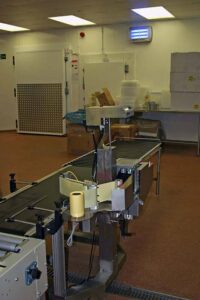Verification
Current standard
P100 producing grade A barcodes in a food factory
EAN128 barcodes require a minimum grade “C”
ITF14 barcodes require a minimum of grade “D”
Why Verify?
Bar code quality is vital, as every time a bar code fails to scan, costs are incurred. At best the data is required to be input manually whilst at worst deliveries are rejected.

A recent survey by the e-centre (EAN UK) put the cost of poor quality bar codes at over £500 million. Until recently, many retailers have accepted these costs as a ‘fact of trading life’. However, an ever-increasing number of major retailers are now taking a very different approach by passing these costs back to suppliers. Goods are returned and fines imposed. For repeat offenders the ultimate sanction can be, and has been, delisting as a supplier.
Why the need for Verification?
GS1 UK and the major supermarkets have spent much time and effort, establishing acceptable bar code quality requirements to ensure that all bar codes can be scanned (read), using a variety of scanners from the entry-level (and simple) to use pen scanners up to and including the very expensive raster scanners used in automated warehousing.

Verification measures the printed quality of the bar code to international (ISO) standards, the standard used by retailers worldwide. According to international standards, verification is mandatory for all companies either designing or printing their own bar codes, ensuring that an acceptable image is created. Once verified, the bar coded label will be given a score this ranges from an “A” (best mark) to an “F” for fail, and the complete inability to read any information on the label.
Despite the complex nature of verification equipment it should be simple to use and display the results in clear, easy to interpret terms. The Quality Assurance representative in charge of verification should be the bar code expert in your organization, thus removing the burden of knowledge from your staff. If the format of the bar code is incorrect, the size too large or too small or the print quality unacceptable, the symbol will fail to scan. The supply chain is broken. The number needs to be entered manually – perhaps incorrectly. A customer incorrectly charged. Wrong goods ordered or dispatched.
Insurance
At its most basic level, verification is an insurance policy helping to assure you that your bar code will scan first time at all levels in the supply chain, thus enhancing your supplier/customer relationship. But it’s more than that. As part of an effective QA system it can help you win business. Are your competitors using verification? Are they questioning the quality of your bar codes with your customers? Is it affecting your business?
Why Can’t I Just Use A Scanner?
Scanning is no substitute for verification as no two bar code readers are identical. They vary from wands to lasers to cameras, from manually operated to automatic. Ambient light will vary as will the distance of scanning. A bar code that is ‘checked’ with a wand gives no guarantee that it will be readable with another wand, let alone a laser based unit.
A verifier is a scientific device, taking precise measurements of each individual bar and space and the amount of light reflected from each. More advanced units will automatically identify the symbology and magnification, check data structure and validate the content as well as providing diagnostic information. It is all very well knowing that your bar code is incorrect but a verifier must be able to identify the problem to allow you to take the necessary corrective action.
In summary, a scanner just reads the information incorporated into the barcode, a verifier reads and evaluates the barcode, giving it a grade between A and F.
Click here for examples of common problems, click here for general requirements

